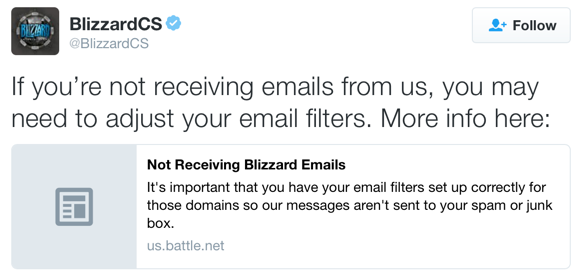Spam Folder
The variables are not independent
In my previous career I was a molecular biologist. Much of my work was done on bacteria but after I left grad school, I ended up working in a developmental biology lab. Bacteria were (mostly) simple: just about every trait was controlled by a single gene. We could study what that gene did by removing it from the bacteria or adding it to a well characterised bacteria.
Read MoreWhy is my cold email going to the spam folder?
Because that’s what the spam folder is for unsolicited email.
Read MoreUse all the channels
One of the hardest deliverability situations to address is when all mail from a certain sender is going to the bulk folder. I’ve had numerous clients come to me to address this situation over the years. Ideally, clients come to me before all their mail is going to bulk. Then we can make some tweaks and changes to their mail program, repair the reputation and then recover other addresses. We have knobs we can twist to fix things if some people are still getting messages in their inbox. We have data to measure.
When all mail is going to bulk, though, we lose access to the knobs and the data. There are zero complaints if mail is going to bulk. There are no opens or clicks, because many ISPs disable images and links in the bulk folder. Our normal “fixing reputation” tools are taken away from us.
Senders with all their mail going to bulk are faced with a profound challenge. How can they engage customers who are unengaged and who are not seeing mail at all? How can we fix deliverability when our normal tools and metrics are unavailable?
If we can get even a small percentage of recipients to go pull mail out of bulk or spam and move it to their inbox, then we’re well on our way to repairing reputation. But how can we get them to go look for the mail in the bulk folder. Recent Litmus research suggests that a significant percentage of folks regularly check their spam folder, but this isn’t always enough to repair reputation,
The question becomes how can the senders encourage recipients to go digging through their spam folder.
This is the point where I start quizzing clients on what other channels they use to communicate with their customers. I’ll run through the whole list: social media, snail mail, push notices through apps, SMS, website popups, Facebook ads. I work with them to identify users who are engaged with their brand and brainstorm ways to get those users to look for mail.
I’m always pleased to see large brands using these strategies. Just recently Blizzard used twitter to communicate with their users about email problems. They tweeted.
The link takes you to the Blizzard support site. Where they give specific instructions on how to whitelist mail and what mail to whitelist.
Recipients and the Spam Button
Earlier this week Litmus and Fluent hosted a webinar title “Adapting to Consumers’ New Definition of Spam.” This had a number of fascinating facts about email marketing, many of which should reassure folks. Litmus has a blog post up highlighting some of the findings specific to millennials and email. Good news is millennials like getting mail from brands and interact with them regularly. Even better, they will rescue mail out of the spam folder.
Litmus has a blog post up highlighting some of the findings specific to millennials and email. Good news is millennials like getting mail from brands and interact with them regularly. Even better, they will rescue mail out of the spam folder.
The full whitepaper is available from Fluent: 2016 Consumer Perceptions of Email. I’ll be writing more about this over the interesting tidbits here over the next few weeks. But I really suggest people go download it and read it.
Delivery challenges increasing
Return Path published their most recent Global Deliverability report this morning. (Get the Report) This shows that inbox placement of mail has decreased 6% in the second half of 2011. This decrease is the largest decrease Return Path has seen in their years of doing this report.
To be honest, I’m not surprised at the decrease. Filters are getting more sophisticated. This means they’re not relying on simply IP reputation for inbox delivery any longer. IP reputation gets mail through the SMTP transaction, but after that mail is subject to content filters. Those content filters are getting a lot better at sorting out “wanted” from “unwanted” mail.
I’m also hearing a lot of anecdotal reports that bulk folder placements at a couple large ISPs increased in the first quarter of 2012. This is after the RP study was finished, and tells me increased bulk folder placement is more likely to be a trend and not a blip.
One of the other interesting things from the RP study is that the differences are not across all mail streams, but are concentrated in certain streams and they vary across different regions.
It's easy to be a sloppy marketer
Sometimes marketers are just sloppy.
Take, for example, an email I received today from a company.
I wasn’t expecting it (sloppy #1).
I never consciously signed up for it (sloppy #2). Apparently I’d bought a package they sold through Appsumo and they claim I asked for future offers. If I did, I didn’t mean to.
The email itself used a template from the sender’s ESP, but whomever wrote the copy didn’t actually proof read it (sloppy #3).
When the inbox isn't the inbox
There was a discussion today on the OI list about email filtering that brought up something I usually don’t mention in delivery discussions. Most email marketers treat the inbox as the holy grail of delivery. Everything about delivery is focused on getting to the magical inbox.
I think, though, that inbox is often just shorthand for “not landing in the bulk or spam folders.”
For some recipients, particularly those of us who get lots of mail, sometimes it’s better to land in a folder rather than the inbox. I have a folder set up, where most of my commercial mail goes. It’s labeled “commercial.” I check it once or twice a day.
This is beneficial to me and to the senders. Why? Because when I check that folder I’m ready to actually look at my commercial mail. I’m looking for those offers.
For someone like me, who does most of their work in their inbox, commercial interruptions are a problem. Commercial mail that ends up in my inbox, which can happen if I’ve been lazy about filters, interrupts me and usually doesn’t get read. But when it’s in my commercial folder? Well, then I can look at it, visit websites and make purchases.
So just remember, it’s not that you want mail in the inbox as much as you want mail somewhere that the recipient will notice it.
Is your mail being bulk foldered?
Daisy at Signup.to posted a list of 11 things to do when mail is going to the bulk folder. Her suggestions are a good start to troubleshooting and fixing persistent bulk foldering of mail.
One thing she doesn’t mention is that while bulk foldering can sometimes be the result of poor content, more often it’s the result of unengaged recipients. Think of bulk foldering this way: the ISP has some subscribers they’re pretty sure want your mail, so they’re not going to block your mail. But they’re pretty sure a lot of subscribers don’t want your mail so they’re not going to deliver it to the inbox.
The trick to getting mail moved out of the bulk folder is to get more people engaged with your email marketing. This is tough to do if they’re not actively checking their bulk folder for mail but there are some ways I’ve helped clients get mail into the inbox.